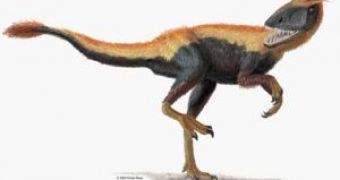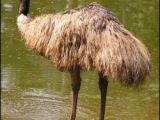Thousands of dinosaur footprints, 167 million years old, impressed in lime of a Middle Jurasic shoreline sea, the Sundance Sea, were discovered at the Red Gulch Dinosaur Tracksite in northern Wyoming.
The prints belong to therapods dinosaur, carnivorous bipedal (the largest and most known theropod is Tyrannosaurus rex, which lived much later than the footprints' species).
Middle Jurassic is a poor era in dinosaur fossils for North America and the footprints are hard to be assigned to any particular species, but the length of strides indicate a human sized animal. "We don't have any documented dinosaur bones and teeth from that period in North America, except for some very scrappy material from Mexico," said Brent Breithaupt, director of the University of Wyoming's Geological Museum in Laramie, Wyoming.
Now, scientists try to get information from the strange pattern of footprints. Instead of speculating, they looked for modern analog animals. Large flightless birds are very similar, and birds indeed descended from theropod dinosaurs.
Ostrich like birds are also roughly human sized, bipedal, and their legs are kept relatively close together, like in the case of the Wyoming dinosaur. Emu (photo) proved to be the best choice. "Ostriches are two-toed, unlike therapods, which had three-toed feet, and have an attitude problem, so that ruled them out".
Rheas have three toes, but are "like working with a bunch of kindergarteners on too much sugar".
"One way to make sense of the 165-million-year-old dinosaur tracks found in northern Wyoming may be found in observing emus, large flightless birds which are about the same size, walk on two legs and have feet similar to that of many dinosaurs," said Breithaupt.
"What emus revealed is that many mysterious dinosaur tracks became quite easily understood when a live animal was seen in action."
Strangely, sometimes a dinosaur's tracks were crossed - that is, the left foot crossing over the right and vice versa. Watching emus, scientists learned that the crossing over is partially the result of the very narrow "straddle" of the trackways because their legs were close together. "Emus share that characteristic and can be seen crossing over feet all the time," said Breithaupt.
Looking at emu walks, researchers surmise that the dinosaurs often stopped and adjusted their position, looking around to get a better idea of their environment. "The tracks we see may represent the dinosaurs stopping in mid-stride as they keep aware of their environment-looking for predators, looking for food, looking for someplace to go," Breithaupt told.
Dinosaur and emu tracks were studied with state-of-the-art photogrammetric techniques, which produce detailed sub-millimeter accuracy photos, able to be computer modeled and made into physical prototypes with rapid prototyping technology. "The bigger picture is also important and telling at the Red Gulch Dinosaur Tracksite," said Breitaupt.
It seems that the dinosaurs were traveling in family groups, since there are juvenile and adult tracks. "That could suggest some sort of parental care, Breithaupt said, or at the very least support the idea that the dinosaurs were social animals, just like modern birds."
Some cautions have to be taken when interpreting the tracks. "Too often people will look at fossil tracks and start making interpretations. I was just very uncomfortable with all the arm-waving. We needed to just spend some time figuring it out and looking at modern animals such as emus which prove to be great modern proxies for the extinct dinosaurs."

 14 DAY TRIAL //
14 DAY TRIAL // 
